Dateline: 10/18/00

A little solar system
What do a human body and a solar system have in common? Hierarchical motion, of course!
Hierarchy, as applied to motion, is just a big word for performing the motions in a very specific
order.
We're going to look at this with VRML but it's applicable to all types of computer graphics systems.
First the mechanics. Let's create a tiny solar system consisting of the Sun, Earth and Moon.
In terms of geometry that's just going to be three spheres with different colors and radii.
Shape {
appearance Appearance {
material Material {
# a green earth
diffuseColor 0 0.7 0
}
}
geometry Sphere { radius 0.5 }
}
Next we're going to need a clock to count time and a couple of OrientationInterpolators to
compute the rotations.
DEF Year TimeSensor {
cycleInterval 12
loop TRUE
}
DEF EarthOrbit OrientationInterpolator {
key [0.0, 0.5, 1.0]
keyValue [
0.0 1.0 0.0 0.0,
0.0 1.0 0.0 3.14,
0.0 1.0 0.0 6.28
]
}
Now on to the issue at hand. In order to place the Earth into orbit around the Sun we must use the
Transform node to position the objects. In fact the Transform node is the key portion. The Transform node
contains the information for positioning and the rotation of the objects. Since we want the Earth to travel around the Sun we must
direct it to rotate around the position of the Sun.
If the Sun is left at the default position of 0,0,0 we must position the Earth some distance away. We
can do this quite easily using the translation field of the Transform node. We need to wrap a Transform Node around
the geometry of the Earth which we can do as follows:
DEF Earth Transform {
translation 10 0 0
children Shape {
appearance Appearance {
material Material {
diffuseColor 0 0.7 0
}
}
geometry Sphere { radius 0.5 }
}
}
This will place the Earth 10 units away from the Sun.
Now let's get things moving.
Next page > Moving Along > Page 1, 2
